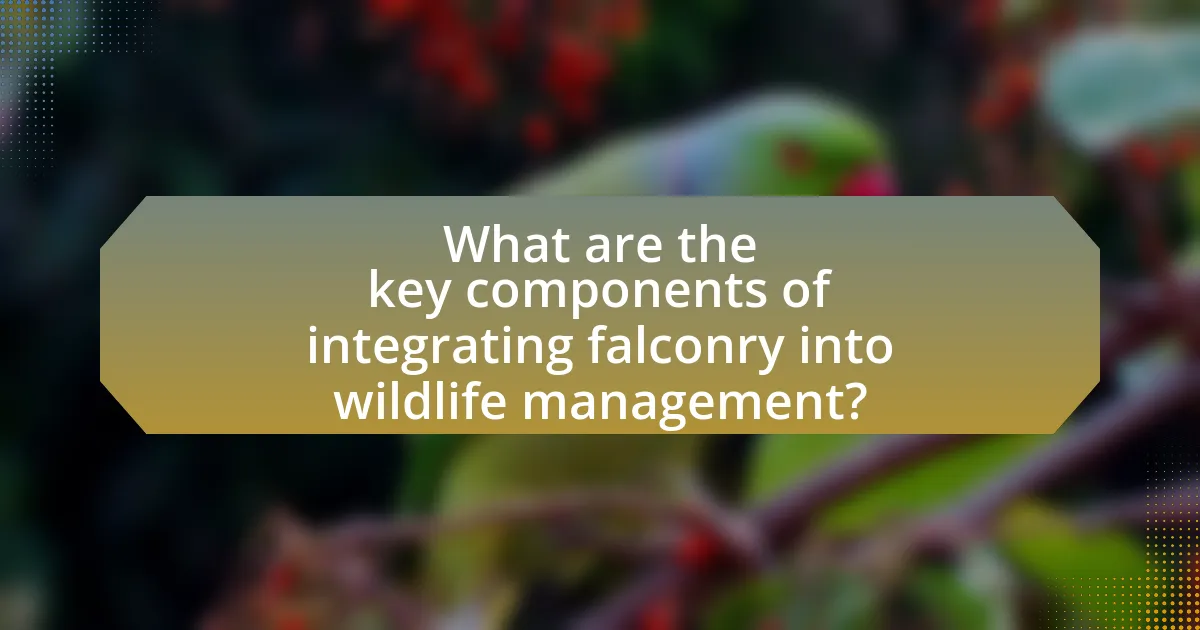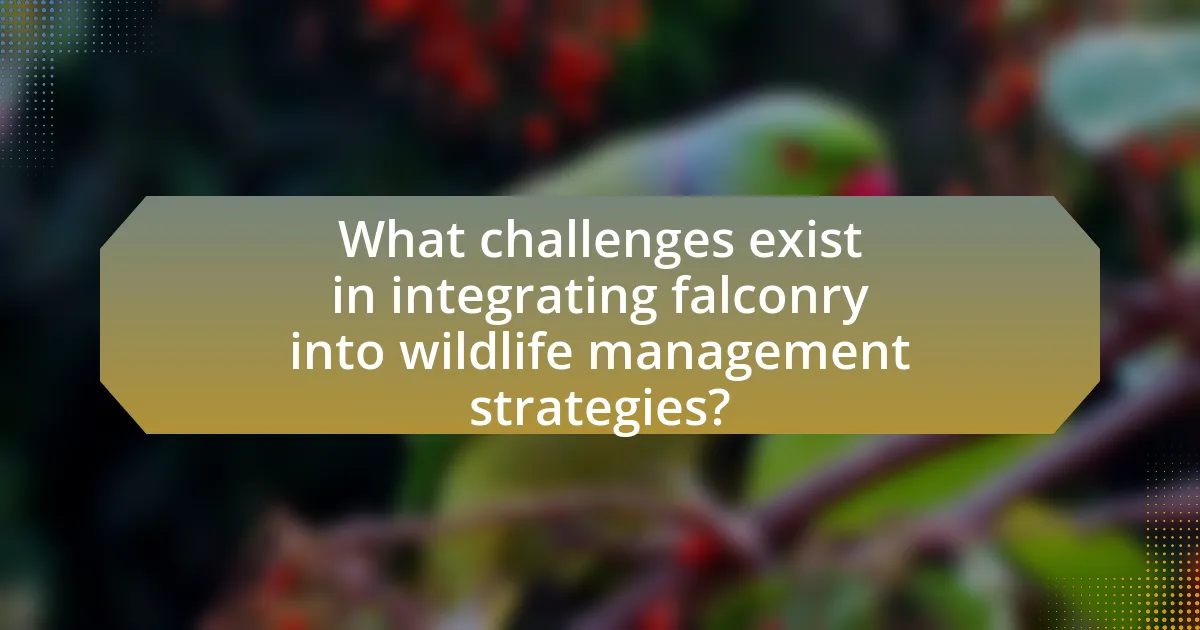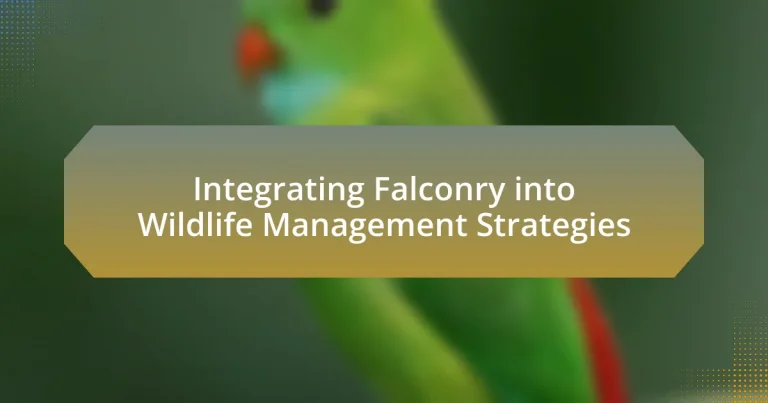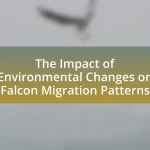Integrating falconry into wildlife management strategies involves the use of trained birds of prey to control populations of pest and invasive species, offering an environmentally friendly alternative to chemical pest control. This practice not only aids in managing species such as rodents and birds that threaten agricultural crops but also promotes biodiversity and ecological balance. The article discusses the techniques employed in falconry, its ecological benefits, the role of falconers, and the legal considerations necessary for its implementation. Additionally, it addresses the challenges and risks associated with falconry in wildlife management, emphasizing the importance of best practices and monitoring techniques to ensure sustainable outcomes.
What is Integrating Falconry into Wildlife Management Strategies?

Integrating falconry into wildlife management strategies involves utilizing trained birds of prey to control populations of certain wildlife species, particularly those that are considered pests or invasive. This method leverages the natural hunting abilities of raptors to manage species such as rodents, birds, and other small animals, thereby reducing their impact on ecosystems and agricultural areas. Studies have shown that falconry can be an effective and environmentally friendly alternative to chemical pest control, as it promotes biodiversity and minimizes harm to non-target species. For instance, research published in the Journal of Wildlife Management highlights the successful use of falconry in agricultural settings to mitigate crop damage caused by pest birds, demonstrating its practical application in wildlife management.
How does falconry contribute to wildlife management?
Falconry contributes to wildlife management by providing a method for controlling pest populations and maintaining ecological balance. This practice utilizes trained birds of prey to hunt and manage species that may become overpopulated, such as rodents or certain bird species, thereby reducing their impact on agriculture and native ecosystems. Studies have shown that falconry can effectively lower the numbers of these species, which helps protect crops and supports biodiversity. For instance, in agricultural settings, the presence of falconry can lead to a significant decrease in crop damage caused by pests, demonstrating its practical application in wildlife management strategies.
What techniques are used in falconry for wildlife management?
Falconry employs several techniques for wildlife management, primarily through the use of trained raptors to control populations of pest species. These techniques include hunting with falcons or hawks to reduce the numbers of small mammals or birds that may threaten agricultural crops or native wildlife. Additionally, falconry can be used to manage invasive species by introducing raptors that prey on these non-native animals, thereby helping to restore ecological balance. Studies have shown that raptors can effectively reduce populations of target species, demonstrating the efficacy of this method in wildlife management.
How does falconry impact the behavior of target species?
Falconry impacts the behavior of target species by altering their movement patterns and foraging behaviors. The presence of trained raptors can induce a heightened sense of predation risk among prey species, leading them to change their habitat use and feeding strategies to avoid detection. Research has shown that when falconry is employed in wildlife management, species such as rabbits and birds often exhibit increased vigilance and altered activity patterns, which can affect their population dynamics and ecosystem interactions. For instance, a study published in the Journal of Wildlife Management demonstrated that the introduction of falconry in a specific area resulted in a significant decrease in the abundance of certain prey species due to their behavioral adaptations to evade predation.
Why is falconry considered a sustainable wildlife management practice?
Falconry is considered a sustainable wildlife management practice because it promotes the balance of ecosystems by controlling prey populations through natural predation. This method reduces reliance on chemical pesticides and other invasive management techniques, thereby preserving biodiversity. Studies have shown that falconry can effectively manage populations of pest species, such as rodents and birds, which can cause agricultural damage, while simultaneously supporting the conservation of raptor species. For instance, the International Association for Falconry and Conservation of Birds of Prey highlights that responsible falconry practices contribute to habitat preservation and species recovery efforts, demonstrating its role in sustainable wildlife management.
What ecological benefits does falconry provide?
Falconry provides ecological benefits by aiding in the control of pest populations, which helps maintain balanced ecosystems. The practice utilizes trained birds of prey to hunt and manage species that may otherwise overpopulate, such as rodents and certain birds, thereby reducing crop damage and disease transmission. Studies have shown that falconry can effectively decrease the numbers of these pests, contributing to agricultural sustainability and biodiversity conservation. For instance, research indicates that the use of raptors in agricultural settings can lead to a significant reduction in rodent populations, which in turn supports healthier crop yields and less reliance on chemical pesticides.
How does falconry compare to other wildlife management methods?
Falconry is a unique wildlife management method that utilizes trained birds of prey to control populations of pest species, distinguishing it from other methods such as trapping, poisoning, or habitat modification. Unlike these conventional techniques, falconry promotes a more natural form of pest control, relying on the predatory instincts of raptors to manage populations without the use of chemicals or significant habitat alteration. Studies have shown that falconry can effectively reduce populations of birds and small mammals in agricultural settings, providing a sustainable alternative that minimizes ecological disruption. For instance, research conducted by the University of Exeter demonstrated that falconry reduced pest bird populations by up to 90% in certain agricultural environments, highlighting its effectiveness compared to traditional methods.
What are the key components of integrating falconry into wildlife management?

The key components of integrating falconry into wildlife management include the establishment of clear objectives, collaboration with wildlife agencies, training and certification of falconers, and monitoring of wildlife populations. Clear objectives ensure that falconry practices align with conservation goals, such as controlling pest species or enhancing biodiversity. Collaboration with wildlife agencies facilitates adherence to regulations and promotes effective management strategies. Training and certification of falconers ensure that practitioners possess the necessary skills and knowledge to handle birds of prey responsibly. Monitoring wildlife populations allows for the assessment of the impact of falconry on ecosystems, ensuring that management practices are effective and sustainable.
What types of birds are commonly used in falconry for wildlife management?
The types of birds commonly used in falconry for wildlife management include the Peregrine Falcon, Red-tailed Hawk, and Harris’s Hawk. These birds are selected for their hunting abilities and adaptability to various environments. The Peregrine Falcon is renowned for its speed and agility, making it effective in controlling bird populations. The Red-tailed Hawk is versatile and can hunt a range of prey, while the Harris’s Hawk is known for its social hunting behavior, allowing it to work effectively in groups. These species have been historically utilized in falconry due to their effectiveness in managing wildlife populations and maintaining ecological balance.
How do different species of falcons vary in their effectiveness?
Different species of falcons vary in their effectiveness based on their hunting techniques, prey preferences, and environmental adaptability. For instance, the Peregrine Falcon is renowned for its high-speed dives, making it exceptionally effective at capturing birds in flight, while the American Kestrel, being smaller, excels in hunting insects and small mammals. Additionally, the Gyrfalcon demonstrates versatility in hunting larger prey in harsher climates, showcasing its adaptability. These differences in hunting strategies and prey selection directly influence their roles in wildlife management, as specific species may be more suited for controlling particular pest populations or managing ecosystems in diverse environments.
What training is required for falcons used in wildlife management?
Falcons used in wildlife management require specialized training that focuses on hunting techniques, recall, and socialization with humans. This training typically involves a process called “manning,” where the falcon is acclimated to human presence and trained to respond to commands. Additionally, falcons undergo training to enhance their hunting skills, which includes practicing with live prey in controlled environments to develop their instincts and abilities. The effectiveness of this training is supported by studies showing that well-trained falcons can significantly reduce populations of pest species, demonstrating their utility in wildlife management.
What role do falconers play in wildlife management strategies?
Falconers play a crucial role in wildlife management strategies by utilizing trained birds of prey to control populations of pest species, such as rodents and invasive birds. This method, known as falconry, is an effective and environmentally friendly alternative to chemical pest control, as it promotes natural predation and reduces the need for harmful pesticides. Studies have shown that falconry can significantly decrease the populations of target species, thereby aiding in the preservation of native wildlife and ecosystems. For instance, falconers have been employed in agricultural settings to protect crops from bird damage, demonstrating the practical application of this traditional practice in modern wildlife management.
What skills are essential for a falconer in this context?
Essential skills for a falconer in the context of integrating falconry into wildlife management strategies include bird handling, training techniques, and ecological knowledge. Bird handling skills are crucial for safely managing raptors, ensuring their well-being, and facilitating effective hunting practices. Training techniques are necessary for developing the falcon’s hunting abilities and ensuring it responds to commands, which is vital for successful wildlife management. Ecological knowledge allows falconers to understand the role of raptors in the ecosystem, enabling them to make informed decisions that support biodiversity and conservation efforts. These skills collectively enhance the effectiveness of falconry as a tool in wildlife management.
How do falconers collaborate with wildlife management agencies?
Falconers collaborate with wildlife management agencies by providing expertise in the use of trained birds of prey for controlling wildlife populations and managing ecosystems. This collaboration often involves falconers assisting in the management of pest species, such as rodents or invasive birds, which can negatively impact native wildlife and agricultural interests. For instance, studies have shown that falconry can effectively reduce populations of certain pest species, thereby supporting biodiversity and agricultural health. Additionally, falconers may participate in research initiatives, share data on bird behavior and ecology, and help educate the public about the benefits of raptor conservation, further enhancing wildlife management efforts.
What challenges exist in integrating falconry into wildlife management strategies?

Integrating falconry into wildlife management strategies faces several challenges, including regulatory hurdles, public perception, and ecological impacts. Regulatory hurdles arise from the need for permits and compliance with wildlife protection laws, which can vary significantly by region. Public perception can be a barrier, as some communities may view falconry as inhumane or unnecessary, leading to resistance against its implementation. Additionally, ecological impacts must be carefully considered, as the introduction of trained raptors could disrupt local ecosystems or affect the populations of target species. These challenges necessitate thorough planning and stakeholder engagement to ensure successful integration.
What are the legal and regulatory considerations for using falconry in wildlife management?
The legal and regulatory considerations for using falconry in wildlife management include compliance with federal, state, and local laws governing the practice. In the United States, the Migratory Bird Treaty Act regulates the capture and use of migratory birds, requiring permits for falconers. Additionally, each state has its own regulations, which may include licensing requirements, restrictions on species that can be used, and guidelines for the care and training of raptors. For example, the U.S. Fish and Wildlife Service mandates that falconers must adhere to specific standards for the welfare of the birds, ensuring that they are not subjected to undue stress or harm. These regulations are designed to protect both the raptors and the ecosystems in which they are utilized, ensuring sustainable practices in wildlife management.
How do regulations vary by region or country?
Regulations regarding falconry and wildlife management vary significantly by region and country due to differing legal frameworks, cultural practices, and conservation priorities. For instance, in the United States, the Migratory Bird Treaty Act governs the use of raptors, requiring permits for falconry, while individual states have their own specific regulations that can further restrict or define practices. In contrast, European countries often follow the EU Birds Directive, which emphasizes the protection of wild birds and their habitats, leading to stricter regulations on falconry practices. Additionally, countries in the Middle East may have more lenient regulations reflecting cultural traditions associated with falconry, such as the UAE’s Falconry Heritage Initiative, which promotes the sport while ensuring conservation efforts. These variations illustrate how local laws and cultural contexts shape the regulatory landscape for falconry and wildlife management.
What permits are necessary for falconry in wildlife management?
To practice falconry in wildlife management, individuals must obtain a falconry permit issued by the relevant state wildlife agency. This permit typically requires applicants to demonstrate knowledge of falconry practices, possess a suitable facility for housing birds of prey, and often includes a background check. Additionally, federal permits may be necessary for the capture and possession of certain species protected under the Migratory Bird Treaty Act. These regulations ensure that falconry is conducted responsibly and in alignment with wildlife conservation efforts.
What are the potential risks associated with falconry in wildlife management?
The potential risks associated with falconry in wildlife management include the disruption of local ecosystems, the potential for disease transmission, and the impact on target and non-target species. Disruption occurs when trained raptors are introduced into an area, potentially leading to changes in prey populations and competition with native predators. Disease transmission can happen if falcons carry pathogens that affect local wildlife, as evidenced by studies showing that raptors can harbor diseases like avian influenza. Additionally, the use of falconry can inadvertently harm non-target species, as raptors may prey on them, leading to declines in those populations. These risks highlight the need for careful management and monitoring when integrating falconry into wildlife management strategies.
How can falconry practices inadvertently harm local ecosystems?
Falconry practices can inadvertently harm local ecosystems by disrupting the natural balance of prey populations. When falconers release trained birds of prey into the wild, these raptors may hunt local wildlife, leading to a decline in certain species. For instance, studies have shown that the introduction of non-native raptors can outcompete local predators for food resources, resulting in decreased biodiversity. Additionally, the feeding habits of falcons can lead to overpredation of specific prey species, which can destabilize local food webs. This disruption can have cascading effects on the ecosystem, affecting not only the prey species but also the predators that rely on them for survival.
What measures can be taken to mitigate these risks?
To mitigate the risks associated with integrating falconry into wildlife management strategies, implementing comprehensive training programs for falconers is essential. These programs should focus on best practices in bird handling, species identification, and ecological impact assessment. Research indicates that well-trained falconers can significantly reduce the risk of harming non-target species and ensure the welfare of the raptors used in management efforts. Additionally, establishing clear guidelines and regulations for falconry practices can help minimize conflicts with local wildlife populations and promote sustainable interactions. Studies have shown that structured oversight and community engagement in falconry initiatives lead to better conservation outcomes and reduced risks to biodiversity.
What best practices should be followed when integrating falconry into wildlife management?
Best practices for integrating falconry into wildlife management include establishing clear objectives, ensuring compliance with legal regulations, and fostering collaboration among stakeholders. Clear objectives guide the purpose of falconry in wildlife management, such as controlling pest populations or enhancing biodiversity. Compliance with legal regulations, such as permits and species protection laws, ensures ethical and responsible practices. Collaboration among stakeholders, including wildlife managers, falconers, and conservationists, promotes knowledge sharing and effective strategies. These practices are supported by successful case studies, such as the use of falconry in urban pest control, which has demonstrated effectiveness in reducing populations of nuisance birds while maintaining ecological balance.
How can wildlife managers effectively train falconers?
Wildlife managers can effectively train falconers by implementing structured educational programs that combine theoretical knowledge with practical experience. These programs should cover essential topics such as raptor biology, handling techniques, and ethical considerations in falconry.
Evidence of successful training methods can be found in established falconry schools and organizations, which often utilize a mentorship model where experienced falconers guide novices. This hands-on approach allows trainees to develop skills in a controlled environment, ensuring they understand both the care of the birds and the responsibilities involved in wildlife management.
Additionally, incorporating fieldwork and real-world scenarios into training enhances the learning experience, as it prepares falconers to apply their skills in various wildlife management contexts.
What monitoring techniques should be implemented to assess the impact of falconry?
To assess the impact of falconry, techniques such as population monitoring, behavioral studies, and habitat assessments should be implemented. Population monitoring involves tracking the numbers and health of both target and non-target species affected by falconry practices, which can provide insights into ecological balance. Behavioral studies focus on observing the interactions between falconry birds and local wildlife, helping to understand predation effects and competition. Habitat assessments evaluate the quality and availability of environments used by both falconers and wildlife, ensuring that falconry does not negatively impact ecosystem integrity. These techniques are supported by research indicating that effective monitoring can lead to sustainable wildlife management practices, as demonstrated in studies like “The Role of Falconry in Biodiversity Conservation” published in the Journal of Wildlife Management.


